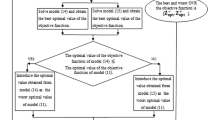Abstract
This paper deals with the fractional linear programming problem in which input data can vary in some given real compact intervals. The aim is to compute the exact range of the optimal value function. A method is provided for the situation in which the feasible set is described by a linear interval system. Moreover, certain dependencies between the coefficients in the nominators and denominators can be involved. Also, we extend this approach for situations in which the same vector appears in different terms in nominators and denominators. The applicability of the approaches developed is illustrated in the context of the analysis of hospital performance.
Similar content being viewed by others
References
Borza M, Rambely AS, Saraj M (2012) Solving linear fractional programming problems with interval coefficients in the objective function. A new approach. Appl Math Sci 6(69–72):3443–3452
Camanho AS, Dyson RG (2005) Cost efficiency measurement with price uncertainty: a DEA application to bank branch assessments. Eur J Oper Res 161(2):432–446
Černý M, Hladík M (2016) Inverse optimization: towards the optimal parameter set of inverse LP with interval coefficients. Cent Eur J Oper Res 24(3):747–762
Charnes A, Cooper WW (1962) Programming with linear fractional functionals. Naval Res Logist Q 9(3–4):181–186
Chinnadurai V, Muthukumar S (2016) Solving the linear fractional programming problem in a fuzzy environment: numerical approach. Appl Math Model 40(11–12):6148–6164
Chinneck JW, Ramadan K (2000) Linear programming with interval coefficients. J Oper Res Soc 51(2):209–220
Effati S, Pakdaman M (2012) Solving the interval-valued linear fractional programming problem. Am J Comput Math 2(1):51–55
Entani T, Tanaka H (2006) Improvement of efficiency intervals based on DEA by adjusting inputs and outputs. Eur J Oper Res 172(3):1004–1017
Fang L, Li H (2013) Lower bound of cost efficiency measure in DEA with incomplete price information. J Product Anal 40(2):219–226
Farrell MJ (1957) The measurement of productive efficiency. J R Stat Soc Ser A 120(3):253–290
Fiedler M, Nedoma J, Ramík J, Rohn J, Zimmermann K (2006) Linear optimization problems with inexact data. Springer, New York
Hatami-Marbini A, Emrouznejad A, Agrell PJ (2014) Interval data without sign restrictions in DEA. Appl Math Model 38(7–8):2028–2036
He F, Xu X, Chen R, Zhu L (2016) Interval efficiency improvement in DEA by using ideal points. Measurement 87:138–145
Hladík M (2010) Generalized linear fractional programming under interval uncertainty. Eur J Oper Res 205(1):42–46
Hladík M (2011) Optimal value bounds in nonlinear programming with interval data. Top 19(1):93–106
Hladík M (2012) Interval linear programming: a survey. In: Mann ZA (ed) Linear programming—new frontiers in theory and applications, chap 2. Nova Science Publishers, New York, pp 85–120
Hladík M (2013) Weak and strong solvability of interval linear systems of equations and inequalities. Linear Algebra Appl 438(11):4156–4165
Hladík M (2014) On approximation of the best case optimal value in interval linear programming. Optim Lett 8(7):1985–1997
Inuiguchi M, Mizoshita F (2012) Qualitative and quantitative data envelopment analysis with interval data. Ann Oper Res 195(1):189–220
Jablonsky J, Fiala P, Smirlis Y, Despotis DK (2004) DEA with interval data: an illustration using the evaluation of branches of a Czech bank. Cent Eur J Oper Res 12(4):323–337
Jahanshahloo G, Soleimani-damaneh M, Mostafaee A (2007a) Cost efficiency analysis with ordinal data: a theoretical and computational view. Int J Comput Math 84(4):553–562
Jahanshahloo G, Soleimani-damaneh M, Mostafaee A (2007b) On the computational complexity of cost efficiency analysis models. Appl Math Comput 188(1):638–640
Jahanshahloo G, Soleimani-damaneh M, Mostafaee A (2008) A simplified version of the DEA cost efficiency model. Eur J Oper Res 184(2):814–815
Jain S, Arya N (2013) Inverse optimization for linear fractional programming. Int J Phys Math Sci 4(1):444–450
Jeyakumar V, Li G, Srisatkunarajah S (2013) Strong duality for robust minimax fractional programming problems. Eur J Oper Res 228(2):331–336
Khalili-Damghani K, Tavana M, Haji-Saami E (2015) A data envelopment analysis model with interval data and undesirable output for combined cycle power plant performance assessment. Expert Syst Appl 42(2):760–773
Kuosmanen T, Post T (2001) Measuring economic efficiency with incomplete price information: with an application to european commercial banks. Eur J Oper Res 134(1):43–58
Kuosmanen T, Post T (2003) Measuring economic efficiency with incomplete price information. Eur J Oper Res 144(2):454–457
Li W, Xia M, Li H (2015) New method for computing the upper bound of optimal value in interval quadratic program. J Comput Appl Math 288:70–80
Li W, Xia M, Li H (2016) Some results on the upper bound of optimal values in interval convex quadratic programming. J Comput Appl Math 302:38–49
Mostafaee A (2011) Non-convex technologies and economic efficiency measures with incomplete data. Int J Ind Math 3(4):259–275
Mostafaee A, Saljooghi FH (2010) Cost efficiency measures in data envelopment analysis with data uncertainty. Eur J Oper Res 202(2):595–603
Mostafaee A, Hladík M, Černý M (2016) Inverse linear programming with interval coefficients. J Comput Appl Math 292:591–608
Rohn J (1981) Strong solvability of interval linear programming problems. Computing 26:79–82
Rohn J (1998) Linear programming with inexact data is NP-hard. ZAMM Z Angew Math Mech 78(Supplement 3):S1051–S1052
Sakawa M, Nishizaki I, Uemura Y (2001) Interactive fuzzy programming for two-level linear and linear fractional production and assignment problems: a case study. Eur J Oper Res 135(1):142–157
Shwartz M, Burgess JF, Zhu J (2016) A DEA based composite measure of quality and its associated data uncertainty interval for health care provider profiling and pay-for-performance. Eur J Oper Res 253(2):489–502
Acknowledgements
M. Hladík was supported by the Czech Science Foundation under Grant P403-18-04735S.
Author information
Authors and Affiliations
Corresponding author
Additional information
Publisher's Note
Springer Nature remains neutral with regard to jurisdictional claims in published maps and institutional affiliations.
Rights and permissions
About this article
Cite this article
Mostafaee, A., Hladík, M. Optimal value bounds in interval fractional linear programming and revenue efficiency measuring. Cent Eur J Oper Res 28, 963–981 (2020). https://doi.org/10.1007/s10100-019-00611-6
Published:
Issue Date:
DOI: https://doi.org/10.1007/s10100-019-00611-6
Keywords
- Linear interval systems
- Fractional linear programming
- Optimal value range
- Interval matrix
- Dependent data




